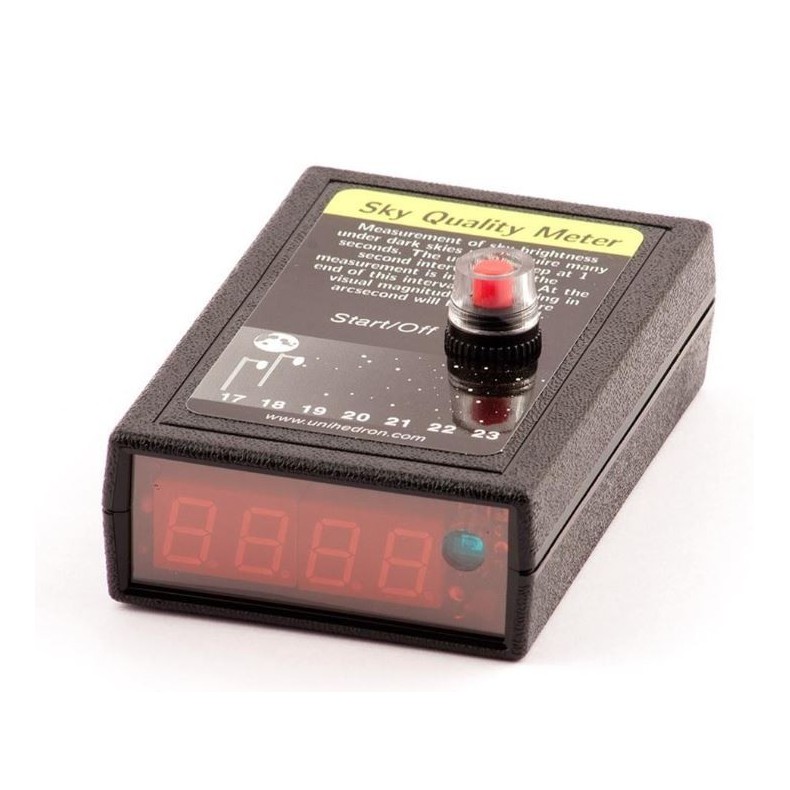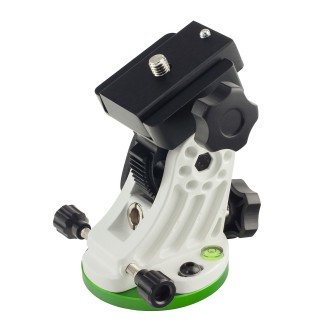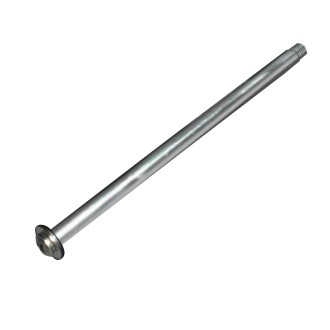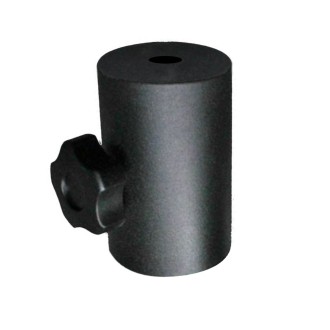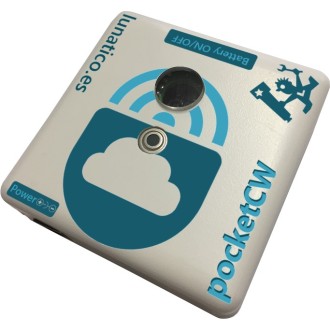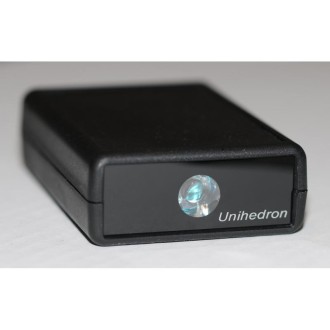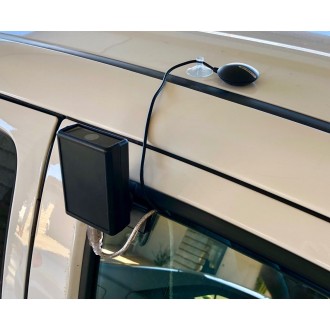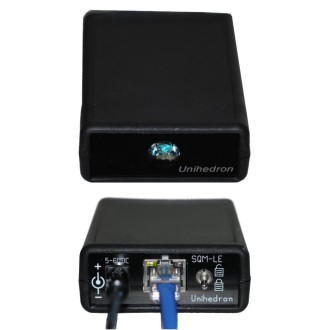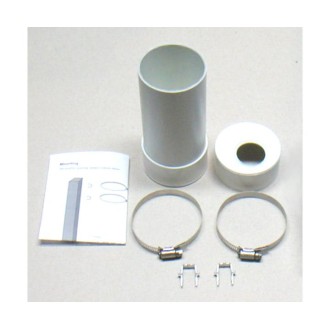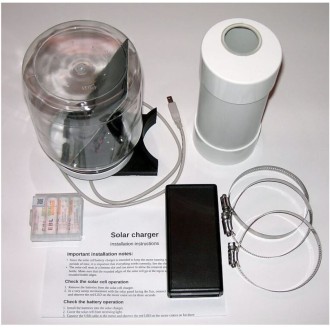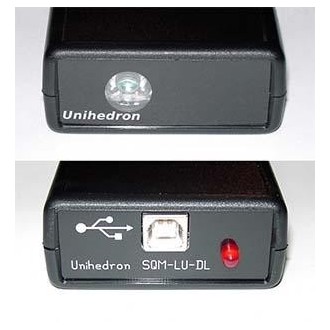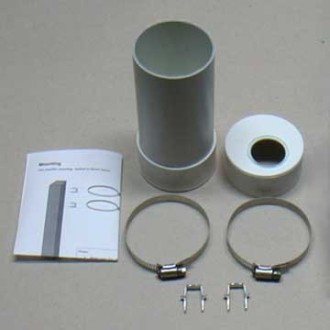Deliver it 8/15 days

Sky Quality Meter Unihedron SQM
- The benchmark to measure the brightness of your sky
- To find or qualify an observation site
- Very easy to use
- Classic version, the most economical
| Carrier | Description | Estimated Delivery | ||
|---|---|---|---|---|
 |
Home delivery - International | Home delivery - International |
Friday, 2 May - Friday, 9 May |
|

Home delivery - International
Home delivery - International
Estimated delivery:
Friday, 2 May - Friday, 9 May
The amateur observer/astrophotographer is constantly on the lookout forthe darkest place to observe and close to home.It is then necessary for him to move and evaluate the quality of this or that potential site at a glance.Unfortunately, this technique is very objective and more qualitative than quantitative and, therefore, unreliable.The limiting visual magnitude test depends on many parameters, including the observer's visual acuity, his state of fatigue, the area of the sky observed, the weather.... Even if a measurement device depends on some of these factors, minimize the number to provide more reliable and accurate data.It is for this purpose that the sky quality meter (SQM) was developed to provide accurate and easily interpretable information on sky qualityAt your favorite observation site(s).
Manufactured by the Canadian firm Unihedron, sQM was developed by Dr. Doug Welch and Anthony Tekatch.The principle is simple,a sensor placed to the right of the digital display receives the radiation produced by the sky background of an observation site.Simply point the case towards the zenith, press the red button and wait for the measurement to be displayed.The measurement time is very short in skies with high light pollution and can be up to 80 seconds in the darkest places.Every second a beep sounds to indicate that the SQM is in the data collection phase.It is important to note that this measurement must be performed without any direct stray light reaching the sensor..The measurement angle of +/- 40° (classic SQM version) on both sides of the zenith must cover an unobstructed observation area (trees, mountains, observer, etc.).
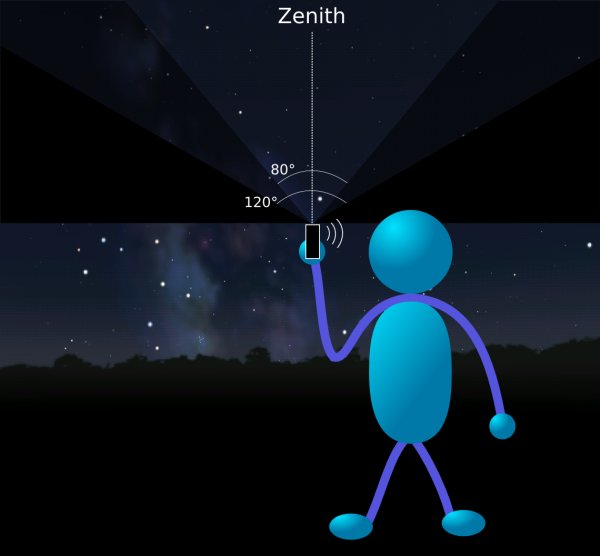
The particularity of SQM is that unlike a visual magnitude test, usually between 4 and 7,the value indicated by the LCD display is greater than 16 and less than 23.In fact, the scale used here is in magnitude per square arcsecond (mag/arcsec2).Consider the "sky background brightness distributed over a square viewing area one arc second on a side.".The indicated result is therefore different from the stellar magnitude of a star (point object).As a reminder: magnitude is an inverse and logarithmic scale of the star's brightness.Thus, the "brighter" stars have a lower magnitude than the "dimmer" stars.A star of magnitude 1 is therefore 2.
The surface magnitude displayed by the SQM is always between 16 (totally clear sky in the city center of a large agglomeration) and no more than 23 (pure sky without light pollution).An observation site where the displayed value is close to 20 is already a sign of a good sky in the field.Remember that even a small difference between two values indicates significant differences in the number of stars visible and the quality of the sky.For convenience, a drawing is shown on the SQM to more easily symbolize the meaning of each value.Note: To find the correspondence with the generally accepted scientific unit of measurement (candela/m2) apply the following formula: [Valor en cd/m2] = 10.8×10,000× 10^(-0.4*[valor en mag/ arcsec2]).
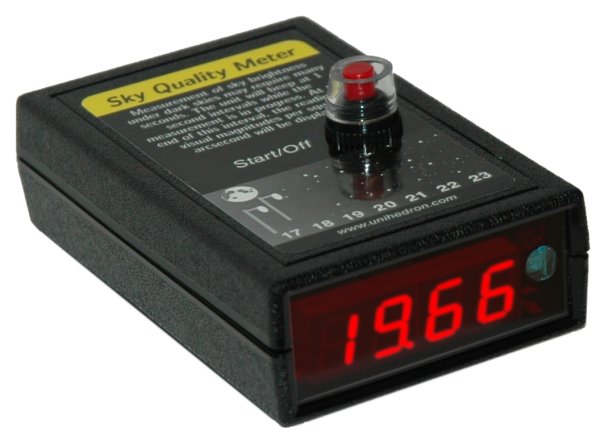
SQM is aimed at two types of users,first to the nomads, who will use it to quantify the quality of various potential observation sites and ultimately choose the best one.Sedentary people with an observatory or a fixed structure to assess the quality of their observing site day after day, year after year.Study the evolution of light pollution in your observation area,for CCD astrophotographers to establish the correlation between a value obtained one evening using the SQM and the noise level (ADC) of the sensor.To provide a value as close to reality as possible, an anti-infrared filter restricts the measurements to the "visual" domain of the spectrum.Manufactured by the Japanese firm Hoya, the CM-500 filter clearly cuts infrared and ultraviolet radiation.Be careful with this glass, if it is covered with dust or fog, the displayed result will be slightly modified.
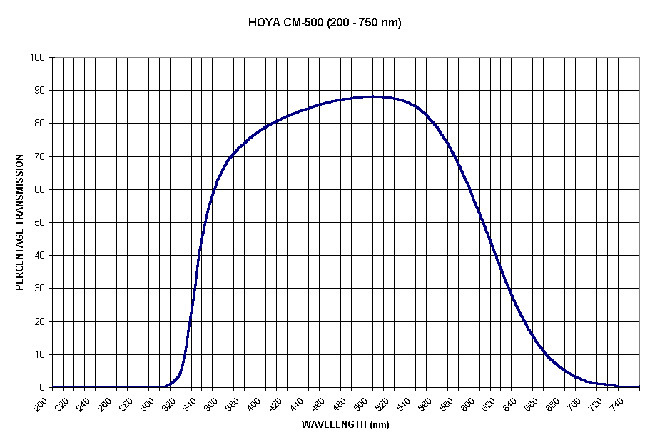
For any measurement the Moon must be absent.The temperature is measured with a thermal probe, its effect on the sensor is subtracted.The display is available in °C and then in °F by pressing the red button twice.The display illumination is available in two levels (low and high).A 9 V battery is provided to sustainably power your sky quality meter.
| aracteristics | SQM Uniedro | ||||||
|---|---|---|---|---|---|---|---|
| Model | SQM | SQM-L | SQM-LE | SQM-LU | SQM-LU-DL | SQM-LU-DL-V | SQM-LR |
| Sensor | TAOS model TSL237S | ||||||
| Protective glass (anti-IR) | HOYA CM-500 | ||||||
| Angle to achieve half width-half height (HWHM) | ~42° | ~10° | |||||
| Monitor | LCD display (temperature in °C or °F) | LCD display (temperature in °C or °F) | / | ||||
| Transfer | / | / | 2m Ethernet cable (T° and magnitude per square arc sec.) | USB-B to USB-C cable | USB-B to USB-C cable | USB-B to USB-C cable | RS-232 cable |
| Temperature (accuracy) | / | / | +/- 2° at 25°C | ||||
| Food | 9V battery included | 9V battery included | AC adapter from 100-240 V to 6 V input (300 mA) | Via USB-B (18mA) | Battery box (6x AA included) | Battery box (6x AA included) | AC adapter from 100-240 V to 6 V input (300 mA) |
| Dimensions | 97x61x25mm | 92x67x28mm | |||||
| Weight | 150g | 140g | 90g | 80g | 80g | 80g | 80g |

